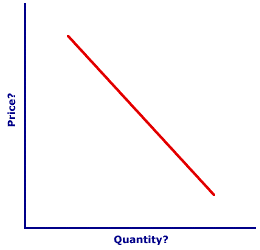
|
|
KEMP-ROTH ACT: Officially titled the Economic Recovery Tax Act of 1981, this was a cornerstone of economic policy under President Reagan. The three components of this act were: (1) a decrease in individual income taxes, phased in over three years, (2) a decrease in business taxes, primarily through changes in capital depreciation, and (3) the indexing of taxes to inflation, which was implemented in 1985. This act was intended to address the stagflation problems of high unemployment and high inflation that existed during that 1970s and to provide greater incentives for investment. A primary theoretical justification is found in the Laffer curve relation between tax rates and total tax collections.
Visit the GLOSS*arama
|
|


|

|
                           AGGREGATE DEMAND AND MARKET DEMAND: The aggregate demand curve, or AD curve, has similarities to, but differences from, the standard market demand curve. Both are negatively sloped. Both relate price and quantity. However, the market demand curve is negatively sloped because of the income and substitution effects and the aggregate demand curve is negatively sloped because of the real-balance, interest-rate, and net-export effects. | Two Similar Curves | 
|
To illustrate the specific aggregate demand and market demand curve similarities and differences consider the graph of a negatively sloped curve displayed here. Is this a market demand curve or an aggregate demand curve? A cursory look suggests that it could be either.To reveal the similarities between the both curves, click the [Market Demand] and [Aggregate Demand] buttons. Doing so illustrates that both curves are negatively sloped, with each virtually overlaying the other. Consider the differences between these two curves. - First, note that for the market demand curve, the vertical axis measures demand price and the horizontal axis measures quantity demanded. For aggregate demand curve, however, the vertical axis measures the price level (GDP price deflator) and the horizontal axis measures real production (real GDP).
- Second, the negative slope of the market curve reflects the law of demand and is attributable to the income effect and the substitution effect. In contrast, the negative slope of the aggregate demand curve is based the real-balance effect, interest-rate effect, and net-export effect. Similar, but different.
Most notable, the differences between market demand and aggregate demand mean that it is not possible to merely add up, or aggregate, the market demand curves for the thousands of goods produced in the economy to derive the aggregate demand curve. The aggregate demand curve dances to its own music and plays be its own set of rules.

Recommended Citation:AGGREGATE DEMAND AND MARKET DEMAND, AmosWEB Encyclonomic WEB*pedia, http://www.AmosWEB.com, AmosWEB LLC, 2000-2024. [Accessed: April 28, 2024].
Check Out These Related Terms... | | | | | | | |
Or For A Little Background... | | | | | | | | | | | | |
And For Further Study... | | | | | | | |
Search Again?
Back to the WEB*pedia
|



|

|
BLUE PLACIDOLA
[What's This?]
Today, you are likely to spend a great deal of time looking for the new strip mall out on the highway hoping to buy either a package of 4 by 6 index cards, the ones with lines or a 50 foot extension cord. Be on the lookout for florescent light bulbs that hum folk songs from the sixties.
Your Complete Scope
This isn't me! What am I?
|

|
|
Lewis Carroll, the author of Alice in Wonderland, was the pseudonym of Charles Dodgson, an accomplished mathematician and economist.
|

|
|
"The roots of education are bitter, but the fruit is sweet." -- Aristotle
|

|
AMW
Average Monthly Wage
|

|
|
Tell us what you think about AmosWEB. Like what you see? Have suggestions for improvements? Let us know. Click the User Feedback link.
User Feedback
|


|


